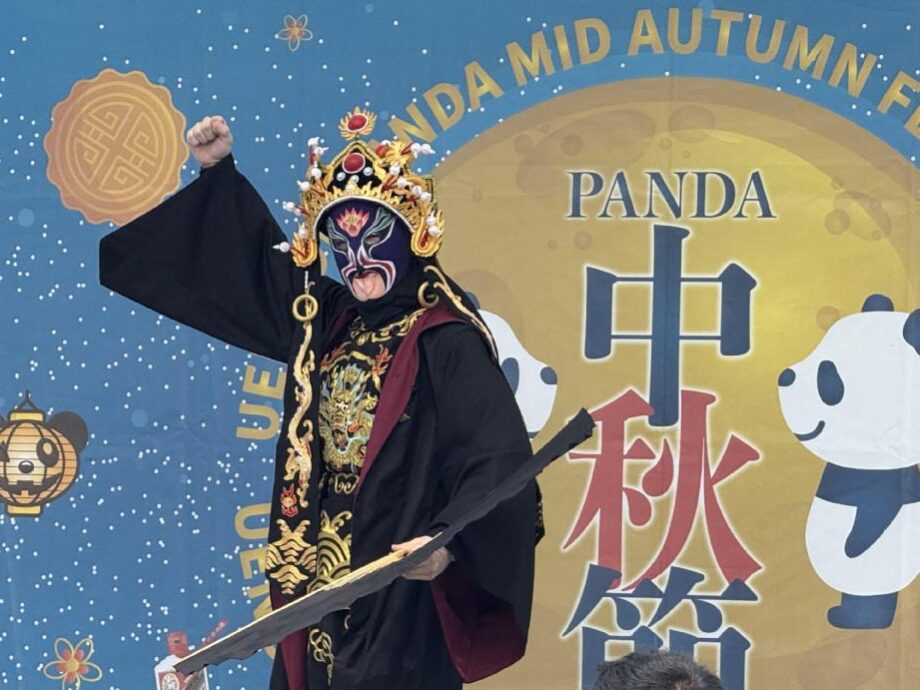A lively start at Ueno Park
Tokyo’s Ueno Park has opened its gates to the 2025 Ueno Panda Mid-Autumn Festival, a three day celebration of food, art, and stage performances that puts the beloved panda at the heart of cultural exchange. The festival began on Friday at the park’s Fountain Plaza, bringing together more than 30 Chinese and Japanese food stalls, over 10 corporate booths, panda themed art installations, and a marketplace of creative goods. New stage programs this year, including the face changing stunts of Sichuan Opera and traditional tea arts, drew large audiences from the moment the music started.
Organizers from China and Japan have framed the panda as a living symbol of friendship between the two countries. Co hosted by China Television Corporation and the Ueno Central Shopping Street since 2023, the event has grown into one of Tokyo’s most recognizable Mid Autumn celebrations, drawing well over 100,000 visitors each year. That momentum is visible again this weekend as families, students, and travelers converge on the plaza for mooncakes, performances, and a parade of panda themed creativity.
Visitor support has been strengthened on site. Volunteers with the Chinese nonprofit Long Gongyi are stationed around the venue to provide basic medical aid and guidance, helping manage crowds and offering directions to rest areas and family zones. Their presence underscores the festival’s emphasis on safety and accessibility for all ages.
What visitors will find on site
The festival runs from 11:00 to 19:00 across three days at Ueno Onshi Park Fountain Plaza, with free admission and open access to all performances. The setting, framed by Ueno’s museums and the zoo, gives the gathering a neighborhood feel while keeping logistics simple for day trippers and travelers.
Food is a major draw. Visitors can sample regional dishes from across China alongside Japanese favorites, then compare assorted styles of mooncakes made only for this season. The vendor lineup includes a mix of long time local shops and new pop ups, while corporate booths offer tastings, giveaways, and product showcases tied to travel, food, and culture.
Stage and tradition
The performance schedule blends classic and contemporary. The face changing art of Sichuan Opera is a crowd pleaser, with performers swapping vividly colored masks in the blink of an eye, a tradition that requires years of practice. Tea arts demonstrations slow the tempo and highlight the ceremony behind brewing and serving, a quiet complement to the noise of the main stage. Idol showcases and live music add a youthful note, echoing the 2024 edition that drew hundreds of dancers and singers to the same plaza. The result is a steady rhythm throughout the day, with audiences moving between food, art, and performance zones.
Art and community
Panda themed installations and creative merchandise give the festival its visual signature. Fans line up for the Everyday Panda Special Photo Exhibition by photographer Takahiro Takauji, which features endearing images of Ueno Zoo’s panda family including Xiang Xiang and her parents Ri Ri and Shin Shin. Commemorative postcards are available for collectors. A community program in partnership with the Taito Ward Social Welfare Council offers event T shirts redesigned with artwork from users of local disability support facilities, with part of the proceeds donated back to those organizations. The mix of professional artists and community makers keeps the marketplace fresh and personal.
Pandas as bridges between China and Japan
Pandas have long played a role in people to people ties between China and Japan. When the two countries normalized diplomatic relations in late September 1972, giant pandas soon arrived at Ueno Zoo, and the public response became part of the shared memory of that era. Subsequent panda arrivals, births, and farewells have continued to spur a sense of connection that extends beyond the zoo.
During the opening ceremony, leaders from cultural and tourism organizations emphasized that spirit. Toshimitsu Doi, president of the Japan Panda Protection Association, praised the burst of creativity surrounding panda art on display in Ueno.
Toshimitsu Doi said: “Combining painting with design is, in itself, a highly enjoyable endeavor. If one recalls the true image of the panda and vividly brings it to mind, the work not only appears more lively but almost feels as if it could bring joy to the panda itself.”
Ouyang An, director of the China National Tourist Office in Tokyo, offered updates on beloved Ueno pandas and recent returns to Sichuan under conservation agreements. His remarks underscored how pandas continue to draw interest from the public in both countries and how joint programs keep that bond active.
The festival’s mission overlaps with a broader push for cultural exchange. At a previous edition, Masato Sakurai, deputy director of the Ueno Tourism Federation, explained why experiencing culture side by side matters for neighbors and newcomers alike.
Masato Sakurai said: “Many people rely on news to learn about events between China and Japan, but I believe that the most important thing is to experience, see and taste things firsthand. Visitors to Ueno Park during the Mid Autumn Festival can interact with Chinese, Japanese and Vietnamese people, which helps dispel prejudices. It is crucial to have personal experiences, such as communicating with restaurant staff when buying Chinese food, as it provides a different perspective compared to just watching the news.”
Why the Mid-Autumn Festival matters
The Mid Autumn Festival is one of the most cherished holidays in the Chinese cultural calendar. Families gather to share mooncakes, light lanterns, and watch the fullest harvest moon of the year. Stories tied to the moon, such as the legend of Chang’e, remain part of the tradition, while regional customs vary from elaborate lantern parades to quiet meals at home. Food is central. Mooncakes, often filled with lotus seed paste, red bean, or nuts, are exchanged as gifts, a sweet symbol of reunion.
Japan has its own moon viewing customs, known as tsukimi, dating back to the Heian period. People arrange pampas grass, enjoy seasonal foods like dango, and take in the night sky. A festival in Ueno that brings together Chinese Mid Autumn traditions and Japanese moon viewing offers visitors a chance to see how similar themes of harvest, gratitude, and family resonate across cultures.
Pandas bring an added layer. The breeding and birthing season for captive pandas often overlaps with the weeks around Mid Autumn, so animal care teams at panda centers in China sometimes mark birthdays with mooncake shaped treats made from safe ingredients like steamed corn bread and fruit. Caretakers tailor the gifts to each panda’s age and personality, and share updates that draw fans closer to conservation work. These small celebrations help connect the public with the science behind a species that once faced steep declines, but has rebounded through long term cooperation.
Ueno Zoo pandas, past and present
For many Tokyo residents, Ueno Zoo is where affection for pandas began. Xiang Xiang, born at Ueno in 2017, became a citywide favorite and later returned to China under standard conservation arrangements. Ueno born cubs have continued that pattern of returning to Sichuan in recent years. The panda family’s story, including parents Ri Ri and Shin Shin, still draws visitors to park exhibitions and events. Photos and films at the festival help keep those memories active for loyal fans and newcomers.
Progress in panda conservation has reshaped the global outlook. In recent years, Chinese research centers reported high survival rates for newborn cubs and many twin births during peak seasons. Advances in breeding, neonatal care, and habitat preparation have improved outcomes, while international exchanges and loan programs have kept the public engaged. That science supports the cultural side of the Ueno festival, where art and education sit next to the snack stalls.
Crowds, access, and safety
Organizers expect heavy foot traffic through the weekend. In 2023, the event drew an estimated 150,000 participants. Since then, it has settled into the city calendar as a reliable draw for families and tourists. The open plaza and clear sight lines make it easier to move around performance areas and food queues. Volunteers from Long Gongyi, easy to spot in vests, provide basic medical support and route guidance to keep the experience running smoothly.
Practical details help plan a visit. Entry is free, with performances and food stalls operating from 11:00 to 19:00 daily. The Fountain Plaza is a short walk from Ueno Station’s park exits, and the site includes seating zones, rest areas, and water stations. Parents with strollers tend to arrive earlier in the day, while the late afternoon brings larger crowds before the evening moonrise. For schedule updates and vendor maps, the official site lists daily highlights and stage times. Visitors can check the program at the festival’s website before heading out.
September in Ueno, a wider cultural backdrop
Ueno in September is packed with events that pair well with the panda festival. The Gei sai school festival at Tokyo University of the Arts puts student creativity in the spotlight with parades, music, and exhibitions. The KOMOGOMO EXPO fills the Fountain Plaza on other dates with booths from young artists and makers. Major museum shows often land in the same window, from classical Japanese history to Western masters. Food tours and night walks in nearby streets add another layer for travelers looking to explore beyond the park.
Families planning a full day can start with a museum visit, head to the panda festival for lunch and performances, then return at dusk for moon viewing. The mix of daytime art, open air snacks, and evening lights suits a range of budgets and ages. Ueno’s compact layout keeps walking times short and the mood lively.
Key Points
- The 2025 Ueno Panda Mid-Autumn Festival runs for three days at Ueno Onshi Park’s Fountain Plaza, 11:00 to 19:00, with free admission.
- More than 30 food stalls and over 10 corporate booths join panda themed art, creative goods, and on stage performances.
- New programs include Sichuan Opera face changing and traditional tea arts, which attracted large crowds at the opening.
- Volunteers from the nonprofit Long Gongyi provide on site medical and guidance services to support visitor safety.
- Co hosted by China Television Corporation and the Ueno Central Shopping Street since 2023, the festival now draws over 100,000 visitors annually.
- Pandas remain a symbol of friendship between China and Japan, a theme highlighted by organizers and panda advocates during the opening ceremony.
- Art features include the Everyday Panda Special Photo Exhibition with images of Xiang Xiang, Ri Ri, and Shin Shin, plus community projects that support local disability services.
- Mid Autumn traditions from China align with Japanese moon viewing customs, offering a shared seasonal experience for families and travelers.




